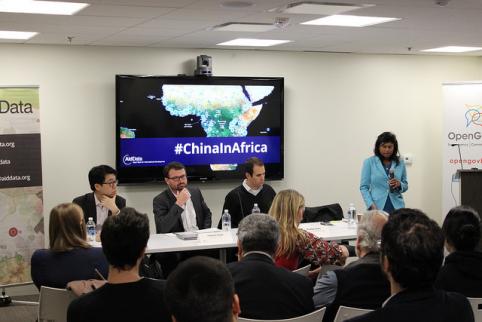At a November 2014 launch event, AidData introduced an interactive geospatial dashboardthat provides detailed information about 1900+ Chinese-funded development projects in Africa. The data are disaggregated to the provincial, municipal, or street-corner level and provided alongside other sub-national data on poverty, economic activity, infrastructure, and conflict. The dashboard attempts to create a space for discussion about China’s role in Africa, opening up a broader conversation where anyone can provide comments and contribute multimedia content on the projects of interest to them.
But the dashboard was not the only feature of the event. AidData released the underlying geocoded dataset from the dashboard, and new AidData working paper analyzing the spatial distribution of Chinese development projects within Africa over a twelve year period “Aid on Demand: African Leaders and the Geography of China’s Foreign Assistance” was co-authored by a group of economists and political scientists from the College of William & Mary, Monash University, University of St. Gallen, and Heidelberg University.
Moderated by Nilmini Rubin, a foreign policy expert with many years of experience on the House Foreign Affairs Committee and the Senate Foreign Relations Committee, the November launch event was the latest installment in AidData’s efforts to make data on and analysis of Chinese development finance more accessible and useful. Brad Parks, AidData’s Co-Executive Director, indicated in his opening remarks at the event that “a lot of researchers run away from uncertainty and imprecision. We did the opposite.” Using its open-source Tracking Underreported Financial Flows (TUFF) approach, AidData triangulates and synthesizes information about Chinese development projects through the use of media reports, government documents, and academic articles, and makes all of this information publicly available via china.aiddata.org.
Through the geospatial dashboard, which was live demoed at the launch event by Scott Stewart, AidData’s Data Manager, users of china.aiddata.org can nowcarefully scrutinize the accuracy and comprehensiveness of our data. The working paper also gives potential users of the data a concrete example of how these data can be used to produce new insights. Andreas Fuchs, from Heidelberg University presented the paper’s main findings: that a disproportionate share of Chinese official finance projects – that is, Official Development Assistance (ODA) and Other Official Financing (OOF) activities – are sited in the birth regions of African leaders. Fuchs’ presentation, delivered to an audience of experts from institutions such as the Brookings Institution, the World Bank, and the Japanese International Cooperation Agency (JICA), also called into question some popular claims about about Chinese aid, such as the assertion hat the allocation of Chinese aid is primarily guided by Beijing’s strong appetite for access to natural resources (Note: Fuchs and his co-authors also released a written statement on this blog to address some misunderstandings and mischaracterizations of what their paper says -- and does not say).

(L to R) Heiwai Tang, Andreas Fuchs, Brad Parks, and moderator Nilmini Rubin (Katie Paulson-Smith)
Heiwai Tang, a professor of international economics at the School of Advanced International Studies (SAIS) at John Hopkins University, then provided feedback on the new analysis. Tang encouraged AidData and the authors of the new working paper to conduct a similar analysis with geocoded aid data on Western donor activities to facilitate comparison . He also underscored the importance of undertaking comparative analysis of Chinese aid and Chinese Outward Foreign Direct Investment (OFDI), and more thoroughly examining the sectoral variation in the existing dataset.
Tang’s response provoked a conversation about the state of open data on Chinese global investment and finance, and was followed by questions from the audience about the paper’s definitions of Chinese official finance (addressed in a previous post on the First Tranche) and the sources used by AidData in the TUFF data collection process. This conversation will no doubt continue in 2015, as AidData is currently preparing to release an updated version of its China-in-Africa dataset and a new-and-improved methodological note that documents the many changes that have been made based on thoughtful feedback from users.
Please join the continuing dialogue on china.aiddata.org or tweet us at @AidData!

